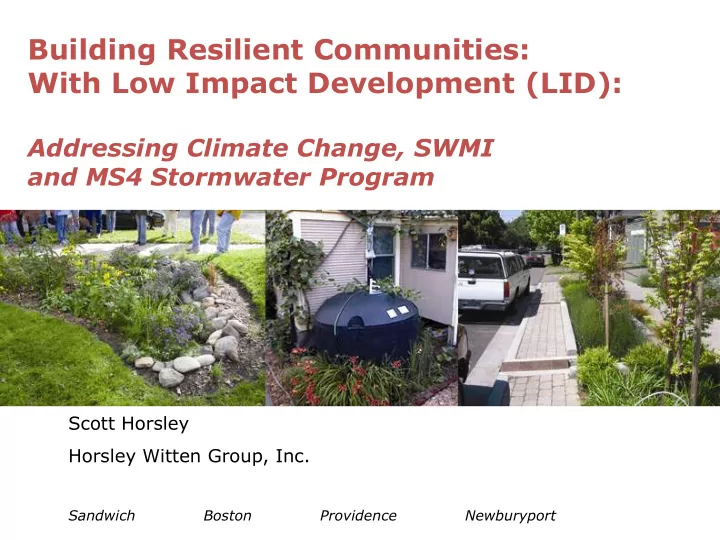

Building Resilient Communities: With Low Impact Development (LID): Addressing Climate Change, SWMI and MS4 Stormwater Program Scott Horsley Horsley Witten Group, Inc. Sandwich Boston Providence Newburyport
Hydrologic Budget Evapotranspiration Runoff Precipitation Stream Recharge Aquifer
Hydrologic Budget Evapotranspiration Pumping Well Septic Precipitation System Road w/ Catchbasin Stream Recharge Aquifer
100-Year Design Storms (inches) Springfield Worcester Boston TP40 Design Storm 6.5 6.5 6.6 (1930 – 1960) Cornell Design Storm 8.8 8.8 8.8 (1936 - 2008) Hydrology Handbook for Conservation Commissions: Appendix F. Rainfall Data for Massachusetts from Rainfall Frequency Atlas of the United States (TP-40). Users of this Handbook should note that current MA DEP written guidance (see DEP Waterlines newsletter -- Fall 2000) requires the use of TP-40 Rainfall Data for calculations under the Wetlands Protection Regulations and the Stormwater Management Policy. More stringent design storms may be used under a local bylaw or ordinance.
Source: University of New Hampshire
No building present on lot, 2005 photo
FEMA 100-year flood, depth > 1 foot, at time building constructed FEMA 100-year flood, depth < 1 foot, at time building constructed Building constructed between 2005 and 2008, in location not designated as FEMA floodplain
Prior 100-year flood, depth > 1 foot 100-year flood, depth >1 foot, from 2010 FEMA study Building constructed between 2005 and 2008, now in regulated floodplain after 2010 FEMA re-study
Same building, March 2010 flood (approximately 40-year flood)
The process begins with determining how many lots could be developed under conventional zoning; this is the base yield of the property. From that point, the plan development process follows four basic steps:
1. Identify Conservation Value Areas on the site such as wetlands, significant trees or tracts of forest, habitat, cultural resources or buffer zones. Remove these from the “developable area”.
2. Place houses in the remaining area in a way that would maximize residents enjoyment of these areas by providing access to open space and preserving views.
3. Align roads and trails on the site to provide pedestrian and vehicle access.
4. Draw lot lines around the homes.
Key Stormwater Regulations Federal Clean Water Act, National Pollutant Discharge Elimination System (NPDES): • EPA 2003 MS4 Permits • EPA General Stormwater Permit (MA) (expected 2013??)
Key Stormwater Regulations Federal Clean Water Act, National Pollutant Discharge Elimination System (NPDES): • EPA 2003 MS4 Permits • EPA General Stormwater Permit (MA) (expected 2013??) Massachusetts Initiatives: • MA Stormwater Standards (jurisdiction under Wetlands Protection Regulations) • MA Water Management Act (Sustainable Water Management Initiative, SWMI) • MA Climate Change Adaptation Report/Regulatory Changes
Key Stormwater Regulations Federal Clean Water Act, National Pollutant Discharge Elimination System (NPDES): • EPA 2003 MS4 Permits • EPA General Stormwater Permit (MA) (expected 2013??) Massachusetts Initiatives: • MA Stormwater Standards (jurisdiction under Wetlands Protection Regulations) • MA Water Management Act (Sustainable Water Management Initiative, SWMI) • MA Climate Change Adaptation Report/Regulatory Changes Local Ordinance/Bylaw/Regulations (required MS4)
LID Stormwater Management Techniques • Rain Barrels and Cisterns / Water Re-use • Stormwater Planters, Tree Planting • Permeable Paving • Open Channels • Bioretention • Stormwater Wetlands • Green Rooftop Systems • Vegetative Buffers • Infiltration
Permeable Pavement
Rain Barrels and Cisterns Runoff Reduction & Water Conservation • Downspouts directed to tanks or barrels • 50 – 10,000 gallons • Excess diverted to drywell or rain garden • Landscaping, car washing, other non- potable uses
Dry Well Infiltration of Roof Runoff Source: CWP Disconnection of Rooftop Runoff to Vegetated Swale Source: Horsley Witten Group
Permeable Pavement
Vegetated Swales Conveyance, Treatment, Infiltration • Roadside swales (“country drainage”) for lower density and small-scale projects • For small parking lots • Mild side slopes and flat longitudinal slopes • Provides area for snow storage & snowmelt treatment
Bioretention Applications • Parking lot islands • Median strips • Residential lots • Office parks Source: Larry Gavin Source: LID Center
Rain Garden
Green Roofs • Stormwater Runoff absorption/collection • Reduced flooding of and damage to urban streets • Interior heating and cooling benefits of 10 degrees or more • Air purification • Recreational amenity • Improved aesthetics • Extended roof life, estimated at 40 years World Trade Center, Boston
Stormwater Planters • Vegetative uptake of stormwater pollutants • Pretreatment for suspended solids before they reach water- treatment facilities • Aesthetically pleasing • Reduction of peak discharge rate
Pet Waste Management
THANK YOU! QUESTIONS?
Recommend
More recommend